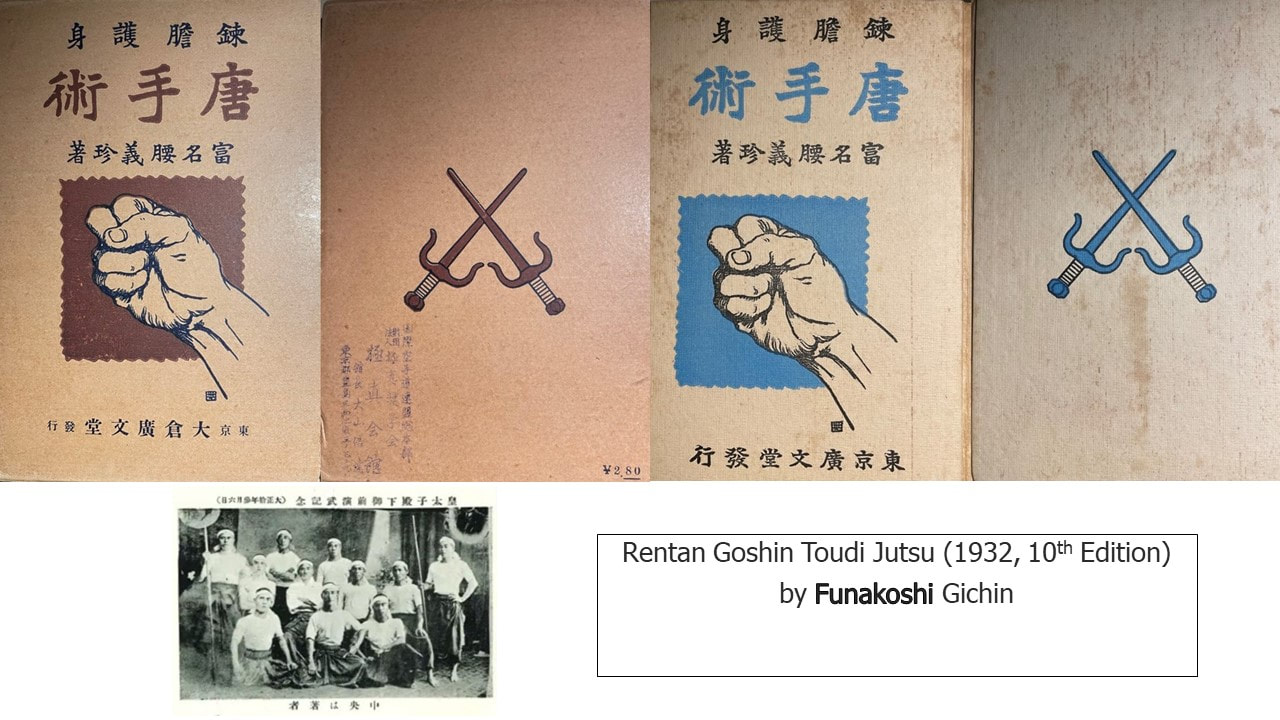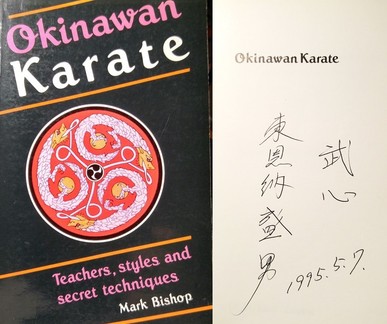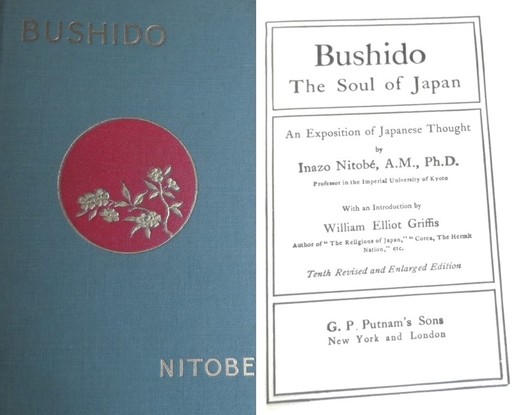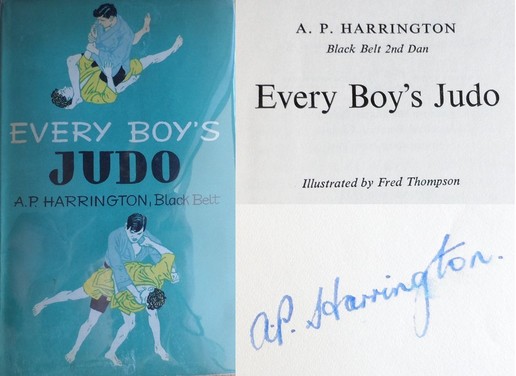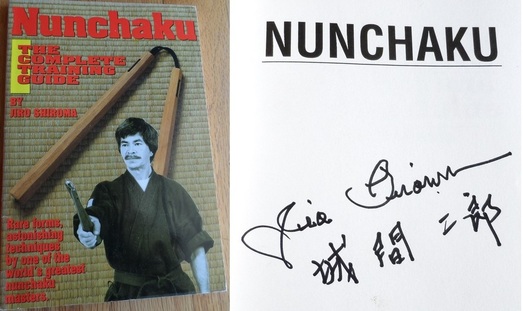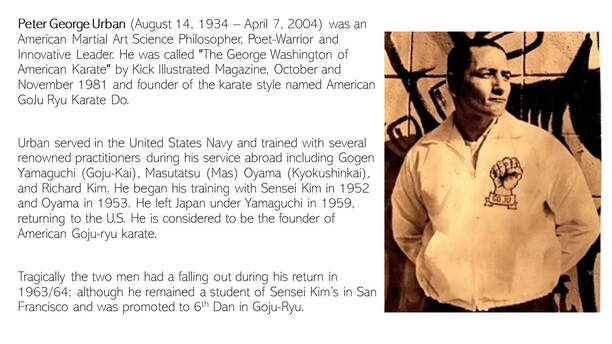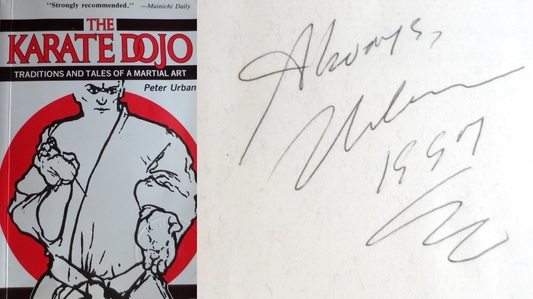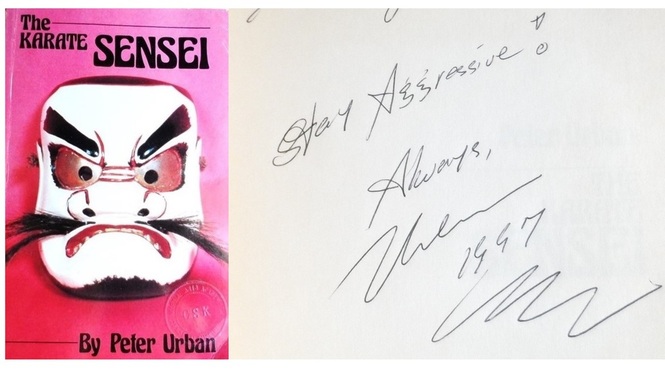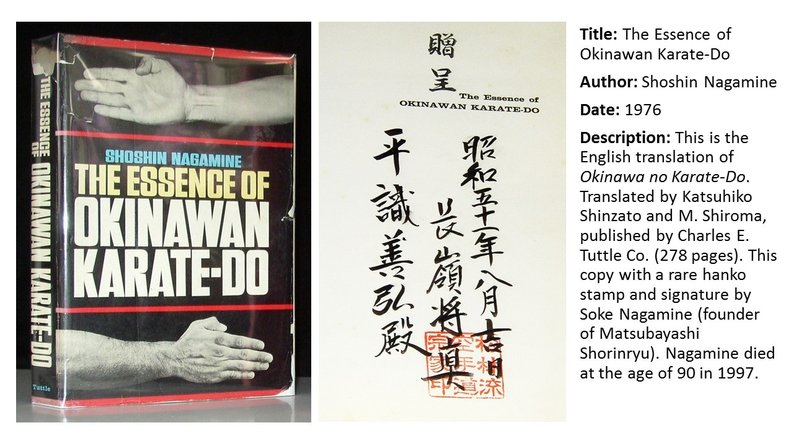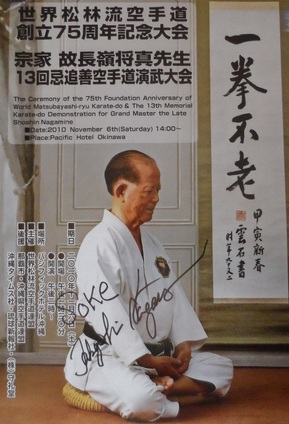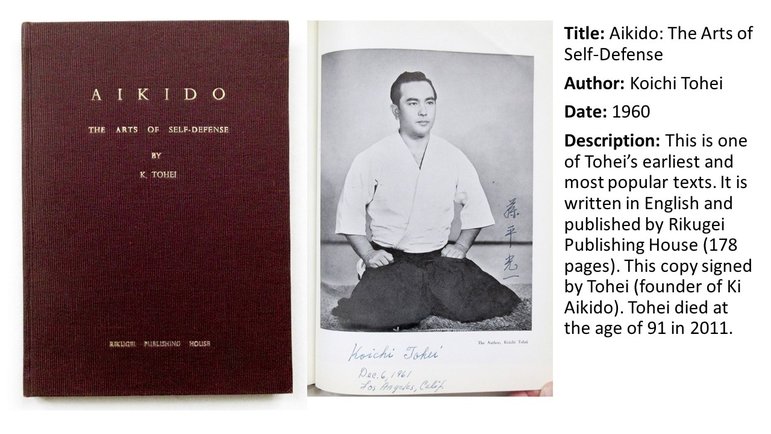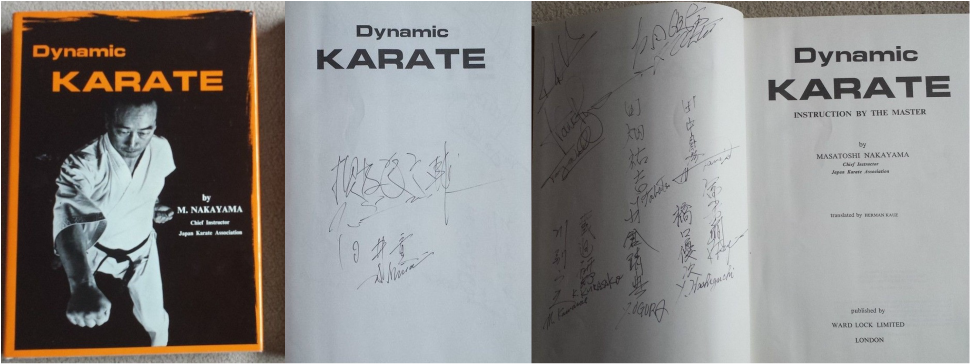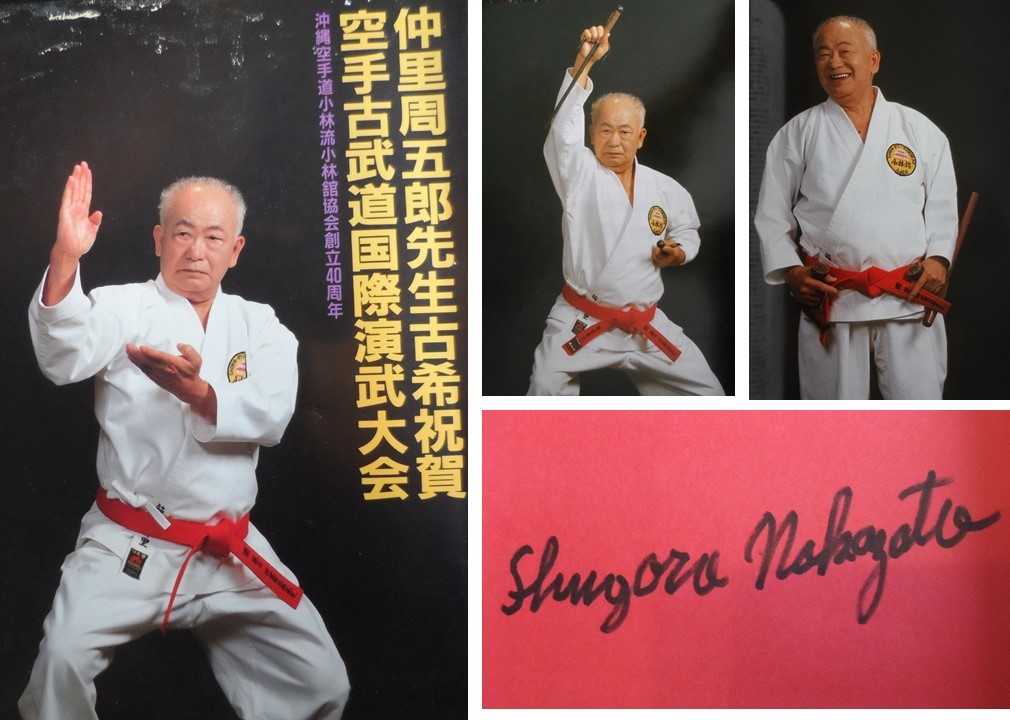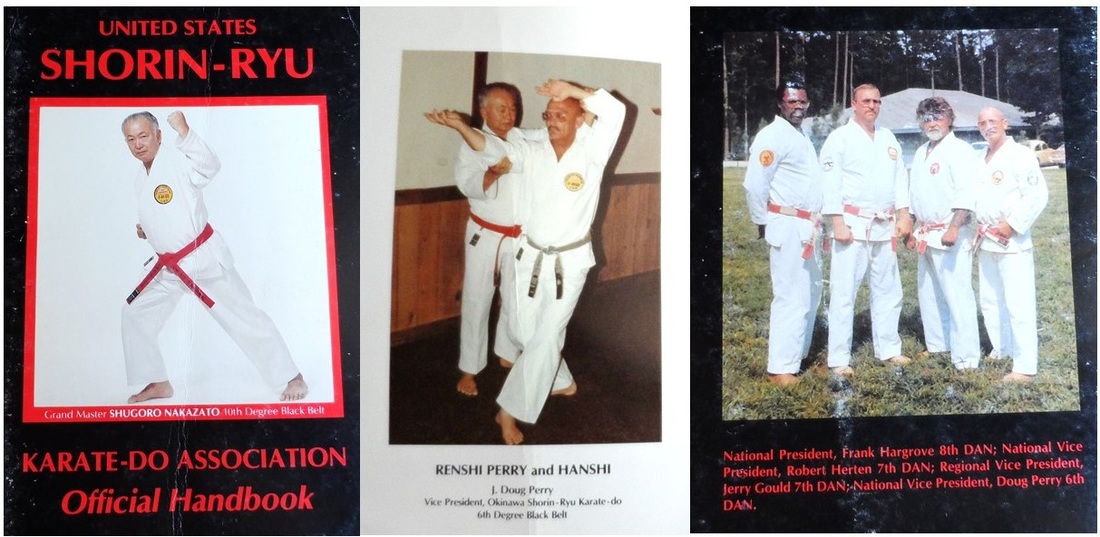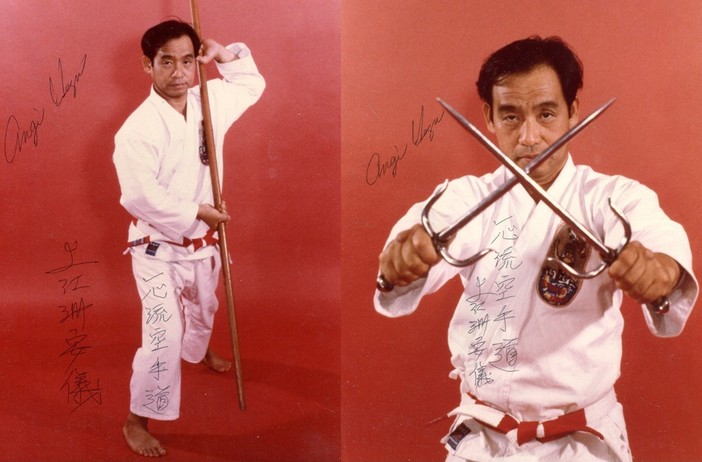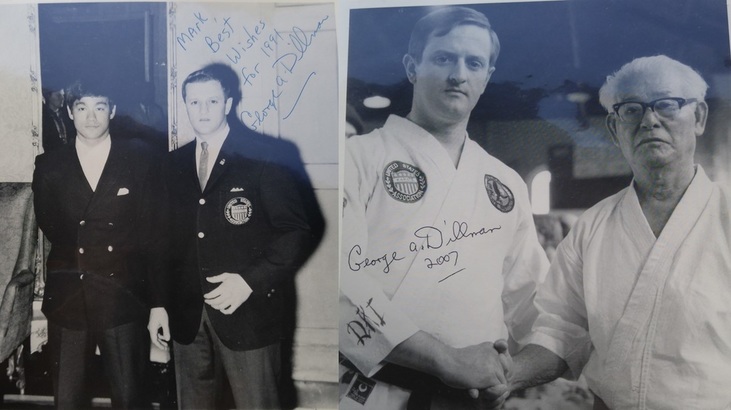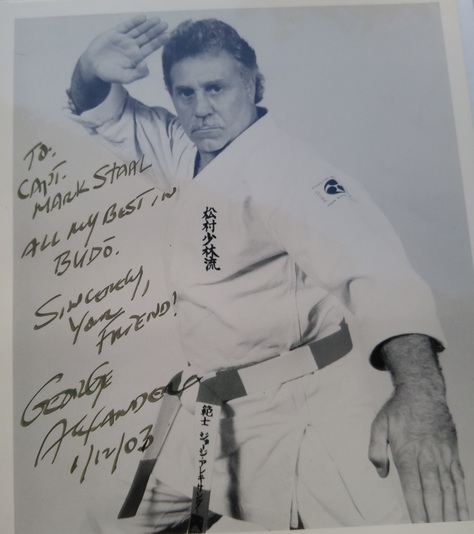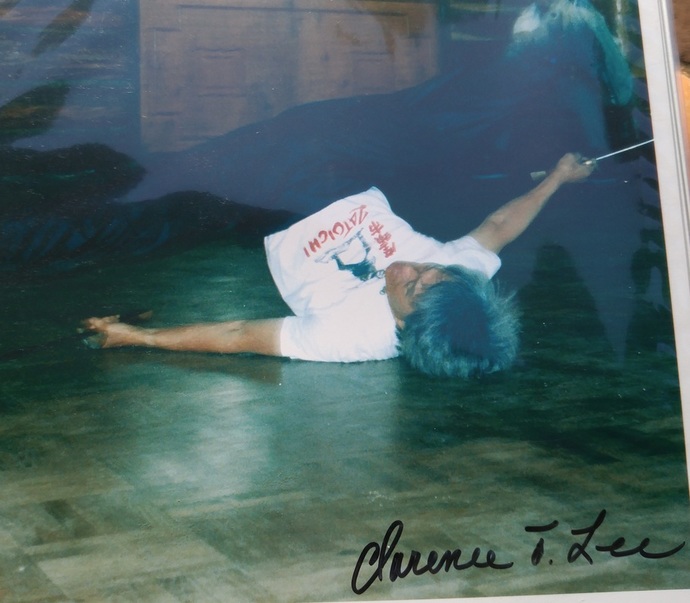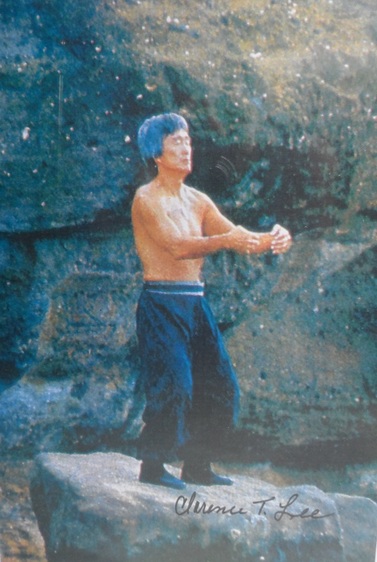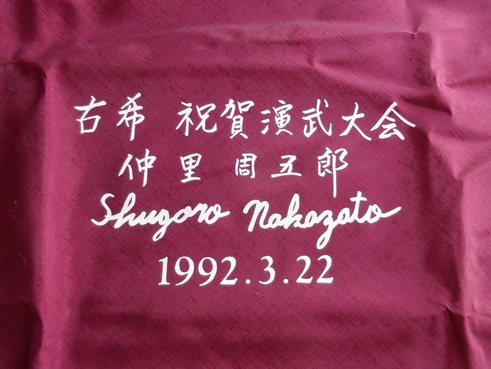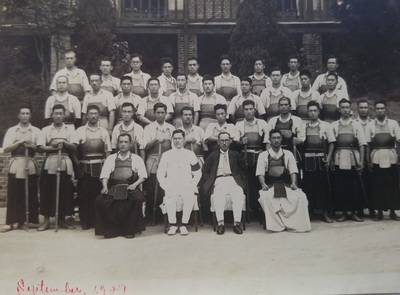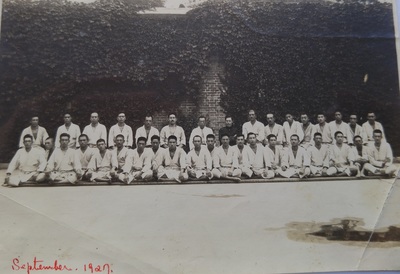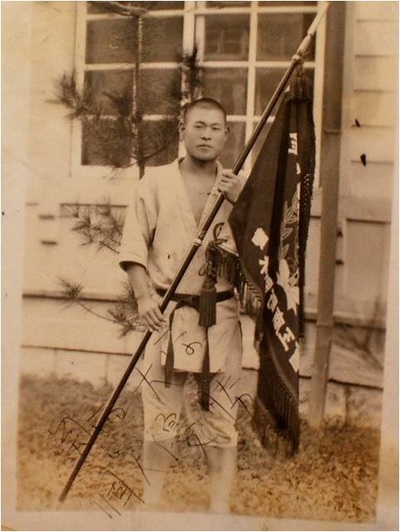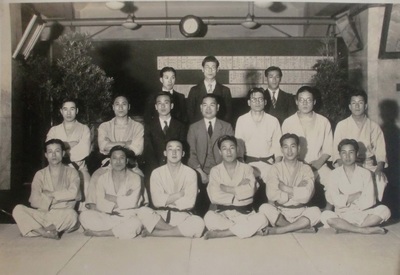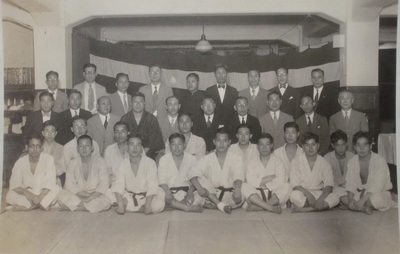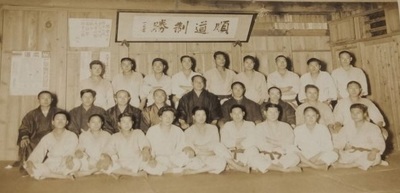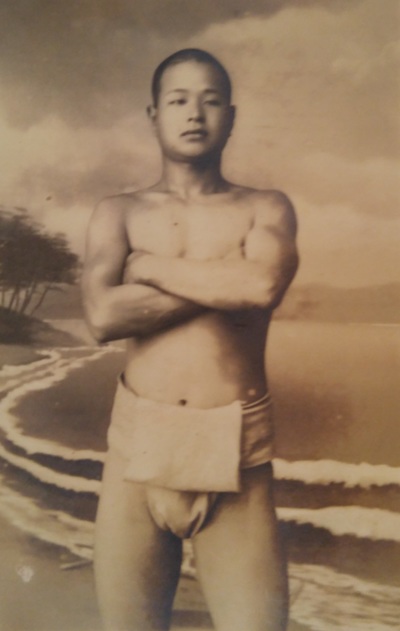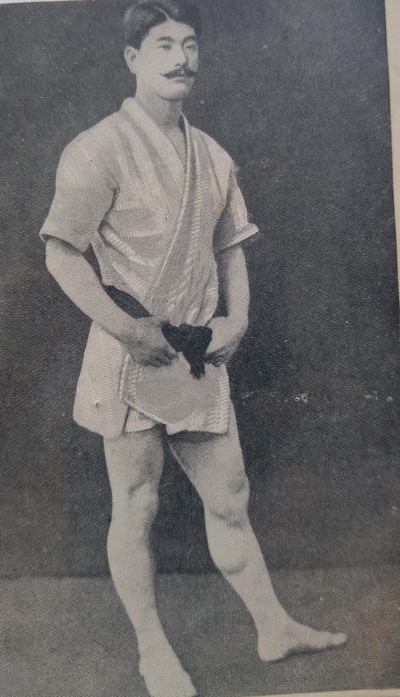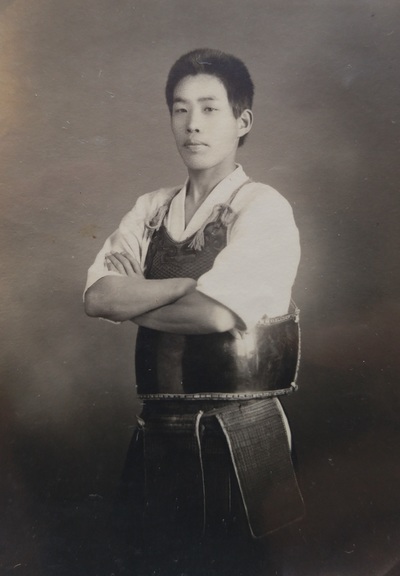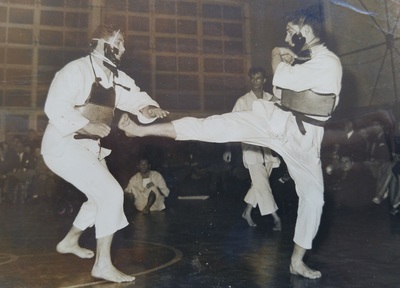Author's Collection of Rare Martial Arts Texts
The following is a handful of rare and important martial arts texts in the author's collection. I welcome inquiries into the purchase of items from this collection. You can reach me with offers and interest at psychodoc@gmail.com
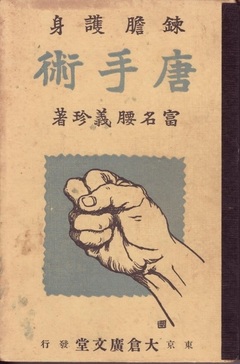
Rentan goshin toudi jutsu by Gichin Funakoshi
Binding: Hardcover
Pages: 209
Images: Over 200 black & white photographs
Language: Japanese
Originally published in 1925
This book is titled "Rentan goshin toudi jutsu" (Toudi arts: Polish your courage for self defense). Its author is Gichin Funakoshi. The book preserved the Shotokan founder’s precious techniques and Kata in 217 photographs, the largest part of which showing Funakoshi performing Kata. In this way this book served the countrywide popularization of Karate in Japan. It contains two group photos, four calligraphies, as well as two photos of Funakoshi. The first part of the book contains a general introduction on history, styles, and etiquette. The second part, called “The System of Karate” contains descriptions and photos of how to make a fist, hand techniques, stances, and Makiwara, followed by foot techniques, Enbusen, and six throwing techniques (Nage-waza). The third part, called “The Fundaments and Kata of Karate,” constituting the main part of this work, contains the full descriptions and photographic documentation of the Kata. The names of the Kata at this Point in time were still the old Okinawan style names: Pinan Shodan, Naihanchi Shodan, and Kūsankū are shown in their entirety. This is followed by the main points shown for the Kata Pinan Nidan to Pinan Godan, Naihanchi Nidan and Naihanchi Sandan, Sēshan, Passai, Wanshū, Chintō, Jitte, and Jion. The fourth part, called “Karate Research Gossip,” has some interesting articles trying to explain the development of Karate as an empty handed art during the kingdom era and others.
Gichin Funakoshi is the founder of shotokan karate-do, perhaps the most widely known style of karate, and is attributed as being the "father of modern karate". Following the teachings of Anko Itosu, he was one of the Okinawan karate masters who introduced karate to the Japanese mainland in 1922. This is a book every karateka should have in their library. It shows rare photos of Master Funakoshi showing his techniques. This book this book, even if damaged, is an authentic piece of history of karate and a must for the serious martial arts collector.
Binding: Hardcover
Pages: 209
Images: Over 200 black & white photographs
Language: Japanese
Originally published in 1925
This book is titled "Rentan goshin toudi jutsu" (Toudi arts: Polish your courage for self defense). Its author is Gichin Funakoshi. The book preserved the Shotokan founder’s precious techniques and Kata in 217 photographs, the largest part of which showing Funakoshi performing Kata. In this way this book served the countrywide popularization of Karate in Japan. It contains two group photos, four calligraphies, as well as two photos of Funakoshi. The first part of the book contains a general introduction on history, styles, and etiquette. The second part, called “The System of Karate” contains descriptions and photos of how to make a fist, hand techniques, stances, and Makiwara, followed by foot techniques, Enbusen, and six throwing techniques (Nage-waza). The third part, called “The Fundaments and Kata of Karate,” constituting the main part of this work, contains the full descriptions and photographic documentation of the Kata. The names of the Kata at this Point in time were still the old Okinawan style names: Pinan Shodan, Naihanchi Shodan, and Kūsankū are shown in their entirety. This is followed by the main points shown for the Kata Pinan Nidan to Pinan Godan, Naihanchi Nidan and Naihanchi Sandan, Sēshan, Passai, Wanshū, Chintō, Jitte, and Jion. The fourth part, called “Karate Research Gossip,” has some interesting articles trying to explain the development of Karate as an empty handed art during the kingdom era and others.
Gichin Funakoshi is the founder of shotokan karate-do, perhaps the most widely known style of karate, and is attributed as being the "father of modern karate". Following the teachings of Anko Itosu, he was one of the Okinawan karate masters who introduced karate to the Japanese mainland in 1922. This is a book every karateka should have in their library. It shows rare photos of Master Funakoshi showing his techniques. This book this book, even if damaged, is an authentic piece of history of karate and a must for the serious martial arts collector.
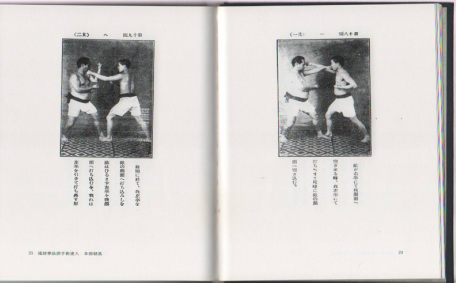
Motobu Choki to Yamada Tatsuo Kenkyu (Research of Choki Motobu and Tetsuo Yamada)
This is a reprint of two books by Choki Motobu (1870-1944) "Okinawa Kenpo Toudi Jutsu Kumite-hen" (his very first book) published in 1926 and "Watashi no Karate Jutsu" (My Karate Art) published in 1932. These are the only two books on Karate ever published by Choki Motobu. This book is dated December 25, 1994.
The book also includes additional works such as the story of Choki Motobu's contest with the boxer John Kentel in Kyoto 1923 that was featured in the Japanese magazine entitled King in September of 1925 (King article states it happened in November 1922) and wonderful pictures of Tatsuo Yamada (1905-1967).
This is a reprint of two books by Choki Motobu (1870-1944) "Okinawa Kenpo Toudi Jutsu Kumite-hen" (his very first book) published in 1926 and "Watashi no Karate Jutsu" (My Karate Art) published in 1932. These are the only two books on Karate ever published by Choki Motobu. This book is dated December 25, 1994.
The book also includes additional works such as the story of Choki Motobu's contest with the boxer John Kentel in Kyoto 1923 that was featured in the Japanese magazine entitled King in September of 1925 (King article states it happened in November 1922) and wonderful pictures of Tatsuo Yamada (1905-1967).
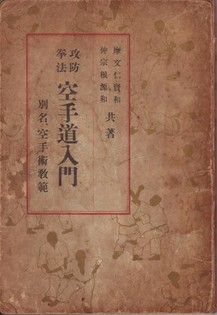
Kobo kenpo karatedo nyumon (An Introduction to karate do: Offensive and Defensive boxing) by Kenwa Mabuni
Binding: Softcover, Pages: 209
Images: About 50 black & white photographs and 200 line drawings. Language: Japanese
Originally published in 1935, this is a 1940 reprint
This book is titled "Kobo kenpo karate-do nyumon" (An Introduction to karate-do: Offensive and Defensive Boxing). Its author is Kenwa Mabuni. Kenwa Mabuni was born in the late 1800s in Okinawa, and from an early age was privileged to study with many of the great martial arts masters of his day. At the age of 13, Kenwa was accepted as a student at the school of the famous karate-do master Anko Itosu, who lived in Shuri. When Kenwa was 20 years old, he began to study the art of Naha-karate or Naha-te with the Grandmaster Kanryo Higaonna. Later both of these major directions of karate-do of Okinawa formed a basis for Shito-ryu karate-do style created by Kenwa Mabuni.
Binding: Softcover, Pages: 209
Images: About 50 black & white photographs and 200 line drawings. Language: Japanese
Originally published in 1935, this is a 1940 reprint
This book is titled "Kobo kenpo karate-do nyumon" (An Introduction to karate-do: Offensive and Defensive Boxing). Its author is Kenwa Mabuni. Kenwa Mabuni was born in the late 1800s in Okinawa, and from an early age was privileged to study with many of the great martial arts masters of his day. At the age of 13, Kenwa was accepted as a student at the school of the famous karate-do master Anko Itosu, who lived in Shuri. When Kenwa was 20 years old, he began to study the art of Naha-karate or Naha-te with the Grandmaster Kanryo Higaonna. Later both of these major directions of karate-do of Okinawa formed a basis for Shito-ryu karate-do style created by Kenwa Mabuni.
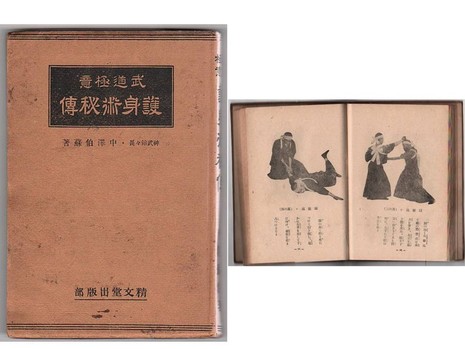
Budo Gokui Goshinjutsu Hiden
“Tips for Self-Protection and Budo Secrets”
Author: Shinto Priest Sohaku Nakazawa,
Publish date is unlisted (est. 1st edition from the early 1920's)
“Tips for Self-Protection and Budo Secrets”
Author: Shinto Priest Sohaku Nakazawa,
Publish date is unlisted (est. 1st edition from the early 1920's)
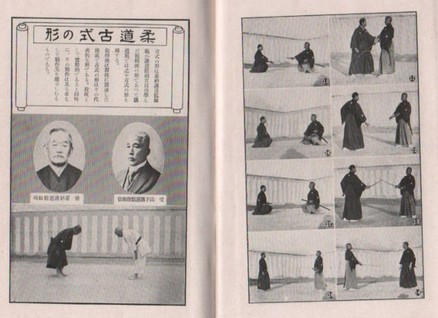
Showa Tenran Shiai and Budo Hokan 2 Volumes (published in 1930).
Two book set depicting various Martial Arts such as Judo, Kendo, Iaido, (Tameshigiri), Naginata, (Tanto), and Jukendo were held in the presence of Emperor Showa. The matches were held at the Imperial Emperor’s Palace. The Tenran Shiai were held three times in 1929, 1930 and 1940. This Tenran Shiai is the first one. Leading figures such as Hakudo Nakayama, Jigoro Kano (Founder of Judo), Hajime Isogai, Shuichi Nagaoka, and Masahiko Kimura took part in this great match. Unlike other Tenran Shiai this book contains Jukenjutsu matches
Two book set depicting various Martial Arts such as Judo, Kendo, Iaido, (Tameshigiri), Naginata, (Tanto), and Jukendo were held in the presence of Emperor Showa. The matches were held at the Imperial Emperor’s Palace. The Tenran Shiai were held three times in 1929, 1930 and 1940. This Tenran Shiai is the first one. Leading figures such as Hakudo Nakayama, Jigoro Kano (Founder of Judo), Hajime Isogai, Shuichi Nagaoka, and Masahiko Kimura took part in this great match. Unlike other Tenran Shiai this book contains Jukenjutsu matches

Soaring into the Karate world
Author: Meitatsu Yagi
Date published: February 10, 1984
Publisher: Kobundo
Pages: 53
Language: Japanese
Author: Meitatsu Yagi
Date published: February 10, 1984
Publisher: Kobundo
Pages: 53
Language: Japanese
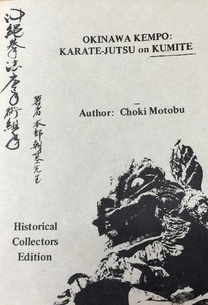
Okinawa Kempo Karate-Jutsu on Kumite by Choki Motobu
Dated 1977
Signed by Oyata (#1417/2000)
Dated 1977
Signed by Oyata (#1417/2000)

Okinawa Kenpo Toudi Jutsu Kumite-Hen (Choki Motobu, 1926) entitled Okinawan Kempo (1995 reprint in English); 130 pages - Limited edition (#1822 of 2000)
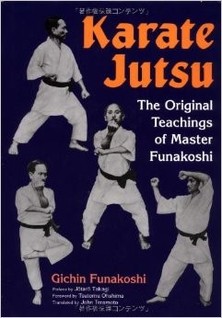
Rentan Goshin Toudi Jutsu (Gichin Funakoshi, 1925) entitled Karate Jutsu: The Original Teachings of Master Funakoshi (2001 reprint in English); 188 pages
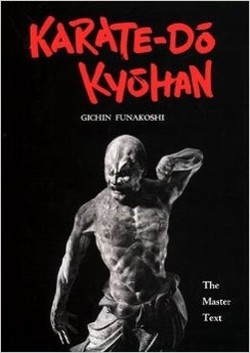
Karate-Do Kyohan: The Master Text (English translation)
by Gichin Funakoshi
Translated by Tsutomu Oshima
Kodansha International Ltd.
Published in 1973
256 pages
by Gichin Funakoshi
Translated by Tsutomu Oshima
Kodansha International Ltd.
Published in 1973
256 pages
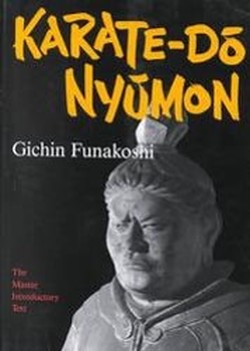
Karate-Do Nyumon
by Gichin Funakoshi (1943)
Translation by John Teramoto
Published in 1988
Kodansha International
119 pages
by Gichin Funakoshi (1943)
Translation by John Teramoto
Published in 1988
Kodansha International
119 pages
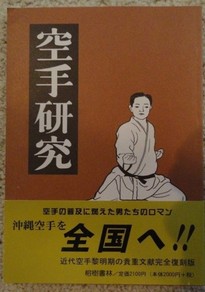
The Study of Karate
Author: Yoju Shorin, 2003 Reprint of 1934 original
Martial arts system/subject: Okinawa Karate
Pages: 135
Language: Japanese
Author: Yoju Shorin, 2003 Reprint of 1934 original
Martial arts system/subject: Okinawa Karate
Pages: 135
Language: Japanese
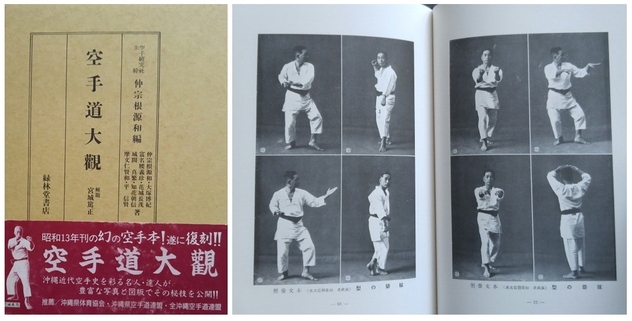
Karatedo Taikan - A Broad View of Karatedo
Chief Editor: Karate Researcher Genwa Nakasone
Authors: Genwa Nakasone, Hironori Ohtsuka, Gichin Funakoshi, Chomo Hanashiro, Shinpan Shiroma, Choshin Chibana, Chojun Miyagi, Shinken Taira
Originally published May 5, 1938 (Showa 13) by Tokyo Tosho. This reproduction September 25, 1991 by Rokurindo Shoten; 414 pages- Japanese language
Chief Editor: Karate Researcher Genwa Nakasone
Authors: Genwa Nakasone, Hironori Ohtsuka, Gichin Funakoshi, Chomo Hanashiro, Shinpan Shiroma, Choshin Chibana, Chojun Miyagi, Shinken Taira
Originally published May 5, 1938 (Showa 13) by Tokyo Tosho. This reproduction September 25, 1991 by Rokurindo Shoten; 414 pages- Japanese language

An Overview of Karate-do (2009)
This is the first English translation of Genwa Nakasone's 1938 Karate-do Taikan. It is one of the most comprehensive books published during the golden age of Karate-do. The book contains chapters of a veritable who's who of Karate-do luminaries including: Shiroma Shimpan, Hanashiro Chomo, Mabuni Kenwa, Otsuka Hironori, and Taira Shinken. The book is richly illustrated and goes into detail about Karate-do history, philosophy, techniques and kata. 310 pages, Publisher: Kowakan Karatedo Ltd.
This is the first English translation of Genwa Nakasone's 1938 Karate-do Taikan. It is one of the most comprehensive books published during the golden age of Karate-do. The book contains chapters of a veritable who's who of Karate-do luminaries including: Shiroma Shimpan, Hanashiro Chomo, Mabuni Kenwa, Otsuka Hironori, and Taira Shinken. The book is richly illustrated and goes into detail about Karate-do history, philosophy, techniques and kata. 310 pages, Publisher: Kowakan Karatedo Ltd.
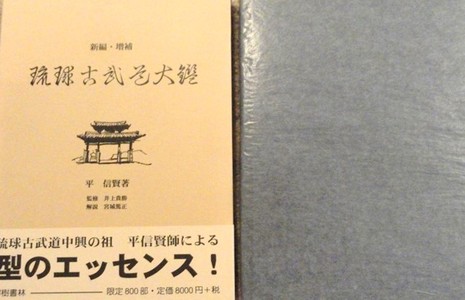
Encyclopedia of Ryukyu Kobudo
Author: Takakatsu Inoue and Shinken Taira
Reprint of original (1964) printing. Date published: August 15, 1997, limited edition of 800 copies
Publisher: Juyo Shorin; Pages: 210; Language: Japanese
Contents: Photographic record, Supporting members, The development of Kobudo, The events of Kobudo, Bo jutsu, Kobujutsu other than Bo jutsu
This is a very rare book. Limited edition to only 800 copies. It is a very well photographed book with all the major kobudo weapons illustrated. It is a hard back book with slip case. It is in Japanese. A must have for the kobudo practitioner.
Author: Takakatsu Inoue and Shinken Taira
Reprint of original (1964) printing. Date published: August 15, 1997, limited edition of 800 copies
Publisher: Juyo Shorin; Pages: 210; Language: Japanese
Contents: Photographic record, Supporting members, The development of Kobudo, The events of Kobudo, Bo jutsu, Kobujutsu other than Bo jutsu
This is a very rare book. Limited edition to only 800 copies. It is a very well photographed book with all the major kobudo weapons illustrated. It is a hard back book with slip case. It is in Japanese. A must have for the kobudo practitioner.
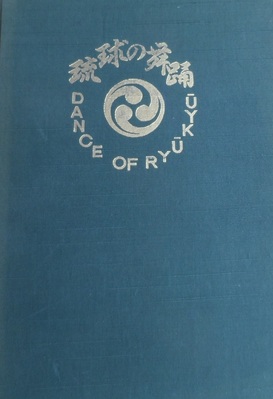
Ryukyu no Buyo - Dance of Ryukyu and Self-Defence
by Seihin Yamanouchi
March 15, 1963 (Showa 38)
266 pages
Japanese and some English language
by Seihin Yamanouchi
March 15, 1963 (Showa 38)
266 pages
Japanese and some English language
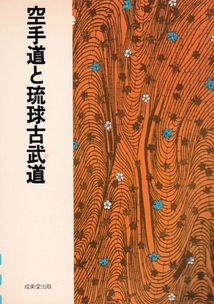
Okinawa Karate-do to Ryukyu Kobudo
Katsumi Murakami
Published: 1973 (March 20th)
Murakami Sensei has trained in jujutsu, kempo, karate-do, Ryukyu kobudo, Chinese quanfa, and holds the rank of Hanshi, 9th dan, in Shorin-ryu Karate-do.
Katsumi Murakami
Published: 1973 (March 20th)
Murakami Sensei has trained in jujutsu, kempo, karate-do, Ryukyu kobudo, Chinese quanfa, and holds the rank of Hanshi, 9th dan, in Shorin-ryu Karate-do.
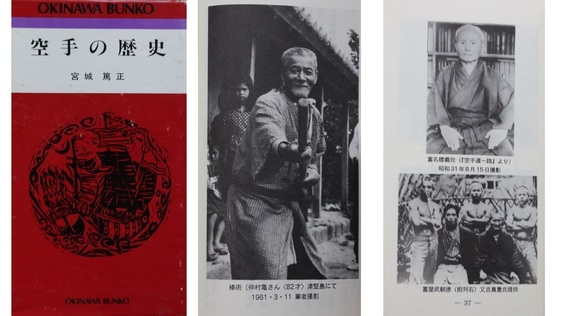
A History of Okinawan Karate
Published in 1990
Japanese language
Published in 1990
Japanese language
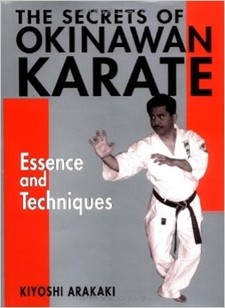
The Secrets of Okinawan Karate: Essence and Techniques
by Kiyoshi Arakaki
2002
Kodansha International
144 pages
by Kiyoshi Arakaki
2002
Kodansha International
144 pages
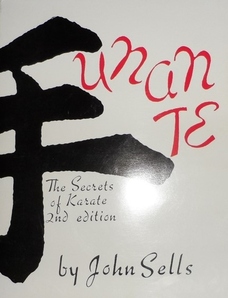
Unante: The Secrets of Karate
by John Sells
2000 edition
W. M. Hawley
350 pages
by John Sells
2000 edition
W. M. Hawley
350 pages
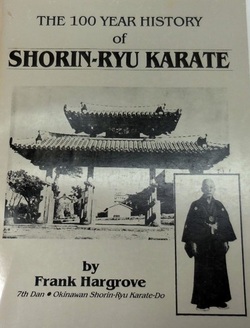
The 100 Year History of Shorin-Ryu Karate
Published: 1988
Author: Frank Hargrove
An excellent snapshot of Kobayashi or Shorinkan Shorin ryu with a series of rare photos of Chibana Sensei performing Kusanku kata. This book is out of print and hard to find.
Published: 1988
Author: Frank Hargrove
An excellent snapshot of Kobayashi or Shorinkan Shorin ryu with a series of rare photos of Chibana Sensei performing Kusanku kata. This book is out of print and hard to find.

Traditional Goju Ryu Karate Volumes 1-4
by Morio Higaonna
Volume 1: Fundamental Techniques (1985)
Volume 2: Performances of the Kata (1987)
Volume 3: Applications of the Kata (1) (1989)
Volume 4: Applications of the Kata (2) (1990)
by Morio Higaonna
Volume 1: Fundamental Techniques (1985)
Volume 2: Performances of the Kata (1987)
Volume 3: Applications of the Kata (1) (1989)
Volume 4: Applications of the Kata (2) (1990)
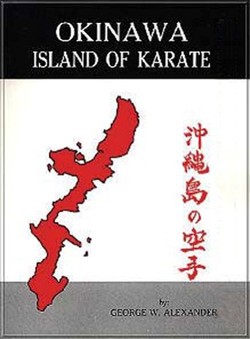
Okinawa: Island of Karate
by George W. Alexander
originally published in September 1991
revised edition August 1998
Yamazato Publications
127 pages
by George W. Alexander
originally published in September 1991
revised edition August 1998
Yamazato Publications
127 pages
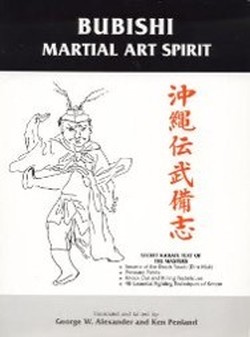
Bubishi: Martial Art Spirit
Secret Karate Text of the Masters
translated and edited by George W. Alexander and Ken Penland
December 1993
Yamazato Publications
180 pages
Secret Karate Text of the Masters
translated and edited by George W. Alexander and Ken Penland
December 1993
Yamazato Publications
180 pages
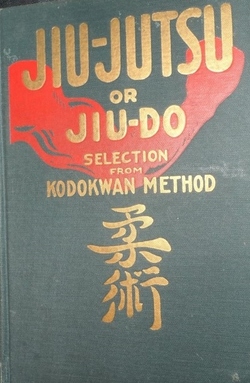
Jiu-Jutsu or Jiu-Do Selection from Kodokwan Method
By K. Yamanaka
Published: 1918
212 pages
Publisher: Rikko Art Company
By K. Yamanaka
Published: 1918
212 pages
Publisher: Rikko Art Company
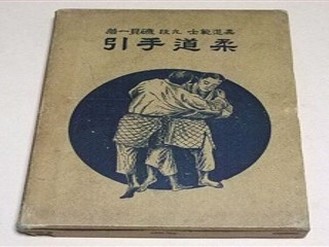
Judo Tebiki (Judo Instruction)
Introduction to Judo
Author Hajime Isogai
Publication year 1925
This is a rare and vintage Judo book by a famous judo Player-Hajime Isogai (1871-1947). First edition was published in 1924. Hajime Sensei was the second man ever promoted to 10th Dan by Jigoro Kano Shihan
Introduction to Judo
Author Hajime Isogai
Publication year 1925
This is a rare and vintage Judo book by a famous judo Player-Hajime Isogai (1871-1947). First edition was published in 1924. Hajime Sensei was the second man ever promoted to 10th Dan by Jigoro Kano Shihan
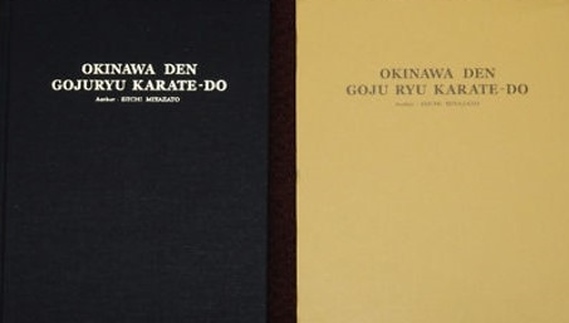
Okinawa Den Goju Ryu Karate-do
by Eizo Miyazato (2006)
(signed)
by Eizo Miyazato (2006)
(signed)
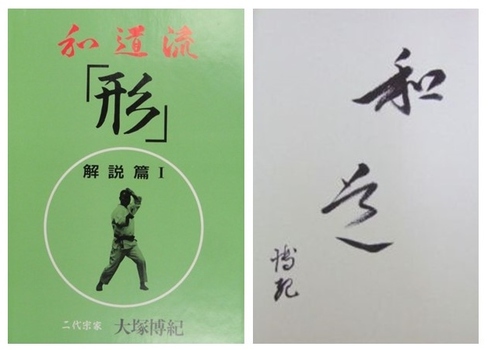
Wado-Ryu Kata
By Otsuka Hironori II (Signed)
The book is dated June 1, 1991 and is a first edition, first printing. Hironori Otsuka founded the Wado Ryu System. Following his death in 1982, Jiro Otsuka helped publish this book. It is a rare and beautiful book 208 pages, Hard Back, with dust jacket. Contents include Letter to the Reader, The Kata of the Wado Style, Vital Points Map, Fundamental Kata, PInan Shodan, Pinan Yodan.
Signed by Otsuka
By Otsuka Hironori II (Signed)
The book is dated June 1, 1991 and is a first edition, first printing. Hironori Otsuka founded the Wado Ryu System. Following his death in 1982, Jiro Otsuka helped publish this book. It is a rare and beautiful book 208 pages, Hard Back, with dust jacket. Contents include Letter to the Reader, The Kata of the Wado Style, Vital Points Map, Fundamental Kata, PInan Shodan, Pinan Yodan.
Signed by Otsuka
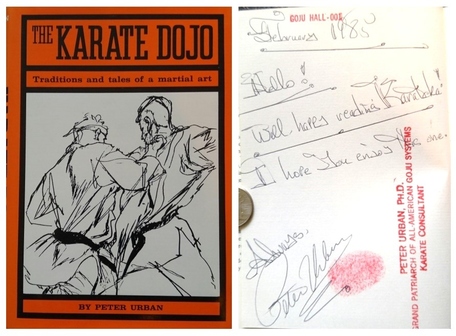
The Karate Dojo
by Peter Urban
1983 edition
Signed by Peter Urban in 1985
by Peter Urban
1983 edition
Signed by Peter Urban in 1985
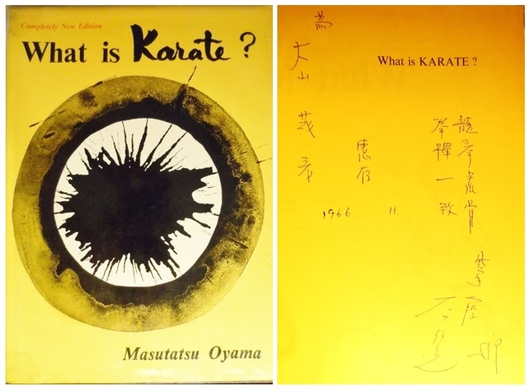
What is Karate?
by Masutatsu Oyama
Published 1966
1st edition
Japan Publications Trading Company
(Rare 1st edition copy signed by Oyama in 1966)
by Masutatsu Oyama
Published 1966
1st edition
Japan Publications Trading Company
(Rare 1st edition copy signed by Oyama in 1966)

This Is Karate
by Masutatsu Oyama
Originally published 1965
1967 edition
Japan Publications Trading Company
367 pages
by Masutatsu Oyama
Originally published 1965
1967 edition
Japan Publications Trading Company
367 pages
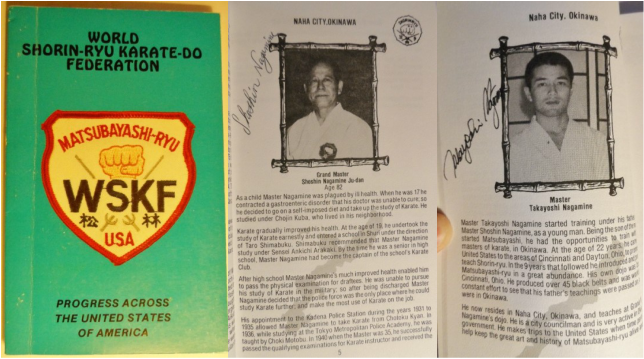
World Shorin-Ryu Karate Do Federation (Matsubayashi Ryu) manual
Signed by Shoshin Nagamine and his son Takayoshi Nagamine in 1985
Signed by Shoshin Nagamine and his son Takayoshi Nagamine in 1985
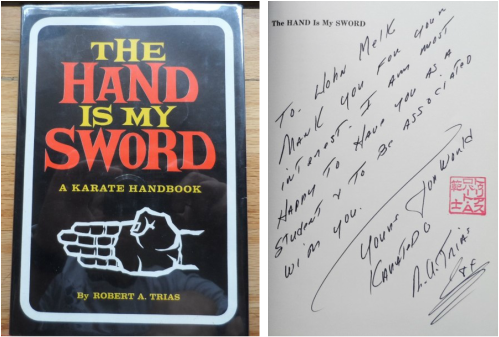
The Hand is My Sword
Author: Robert Trias
Publisher: Tuttle Publishing
Publication Date: 1989
Binding: Hardcover
Signed by Master Trias
Author: Robert Trias
Publisher: Tuttle Publishing
Publication Date: 1989
Binding: Hardcover
Signed by Master Trias

Masanao Takazawa (Founder of Kei Shin Kan). Takazawa was a student of Kanken Toyama. Toyama was born in Shuri (1888) under the given name Kanken Oyadamari training under Itarashiki and later Anko Itosu. Toyama is known as the founder of Shu Do Kan, "the hall for the study of the way) and died in 1966. Toyama promoted Takazawa to 8th Dan before his death and provided him a school (as Toyama's senior student). This picture comes from the personal collection of Robert Trias "the father of American karate" and was given to him in 1971 by Takazawa Sensei in friendship.
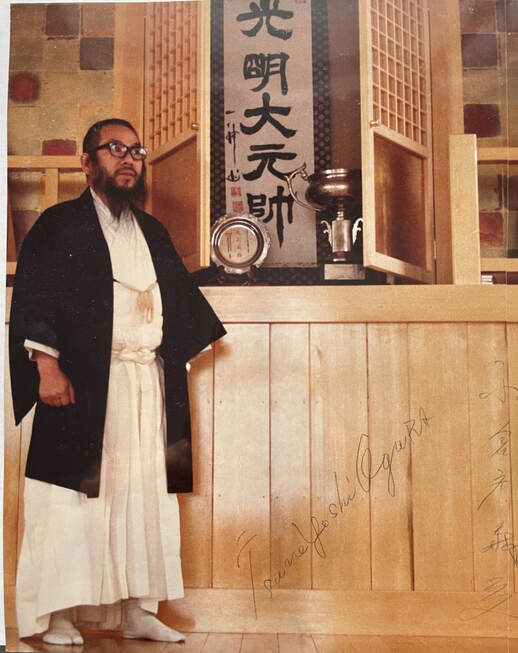
Tsuneyoshi Ogura - founder of Gen Bu Kai karate. Tsyneyoshi was a student of Gogen Yamaguchi (founder of Goju Kai) and Kenwa Mabuni (founder of Shito Ryu). Ogura was born in 1909 and studied in the dojo's of Yamaguchi and Mabuni until starting his own school in Japan in 1944. This letter comes from the personal collection of Robert Trias, "father of American karate".
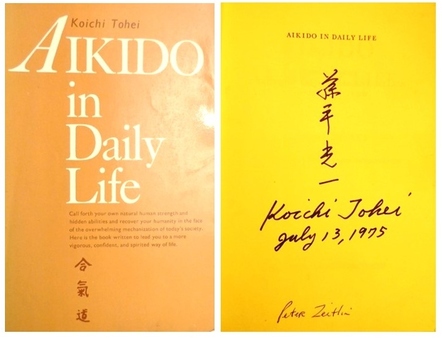
Aikido in Daily Life
By Koichi Tohei
Published 1972
Signed by Tohei in 1975
By Koichi Tohei
Published 1972
Signed by Tohei in 1975
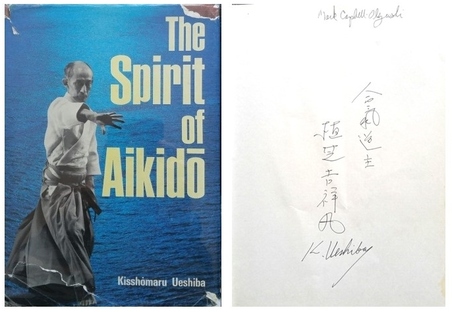
The Spirit of Aikido by Kisshomaru Ueshiba (son of O sensei, founder of Aikido)
Signed by Ueshiba (1985)
Signed by Ueshiba (1985)
Dynamic Karate
by Mastatoshi Nakayama (1973)
Multiple signatures of various Shotokan autographs:
Keinosuke Eneoda, 10th Dan Shotokan (4 July 1935 – 29 March 2003)
Chief Instructor, Karate Union of Great Britain (Student of Masatoshi Nakayama)
Hiroshi Shirai, 10th Dan Shotokan (31 July 1937 - )
Founder of the Instituto Shotokan Italia (1962 JKA Grand Champion)
Masao Kawasoe, 8th Dan Shotokan (1945 - ); Kazumi Tabata, 8th Dan Shotokan (1943 - ); Founded the North American Karate-Do Federation (NAKF) and the New England Collegiate Karate Conference (NECKC); Yasunori Ogura, 7th Dan Shotokan (1958 - ); Shinobu Hashiguchi, 8th Dan Shotokan; Masahiko Tanaka, 8th Dan Shotokan (1941 - ) Twice JKA All-Japan kumite champion; Keiji Tomiyama, 7th Dan Shito Ryu; Yoshinobu Ohta, 7th Dan Shotokan Chief Instructor, JKA England; Terry O'Neill, 7th Dan Shotokan Actor, former kumite champion; Frank Brennan, 7th Dan Shotokan; Bob Rhodes, 7th Dan Shotokan
by Mastatoshi Nakayama (1973)
Multiple signatures of various Shotokan autographs:
Keinosuke Eneoda, 10th Dan Shotokan (4 July 1935 – 29 March 2003)
Chief Instructor, Karate Union of Great Britain (Student of Masatoshi Nakayama)
Hiroshi Shirai, 10th Dan Shotokan (31 July 1937 - )
Founder of the Instituto Shotokan Italia (1962 JKA Grand Champion)
Masao Kawasoe, 8th Dan Shotokan (1945 - ); Kazumi Tabata, 8th Dan Shotokan (1943 - ); Founded the North American Karate-Do Federation (NAKF) and the New England Collegiate Karate Conference (NECKC); Yasunori Ogura, 7th Dan Shotokan (1958 - ); Shinobu Hashiguchi, 8th Dan Shotokan; Masahiko Tanaka, 8th Dan Shotokan (1941 - ) Twice JKA All-Japan kumite champion; Keiji Tomiyama, 7th Dan Shito Ryu; Yoshinobu Ohta, 7th Dan Shotokan Chief Instructor, JKA England; Terry O'Neill, 7th Dan Shotokan Actor, former kumite champion; Frank Brennan, 7th Dan Shotokan; Bob Rhodes, 7th Dan Shotokan
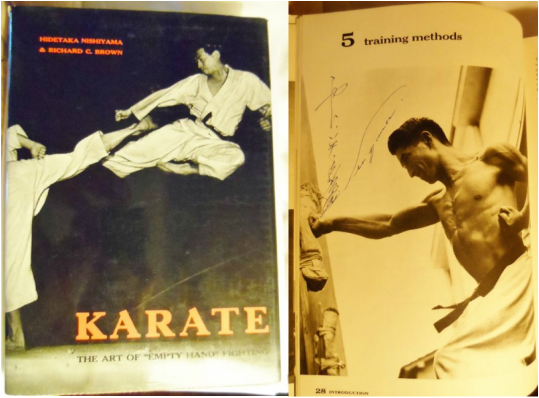
Karate: The Art of "Empty Hand" Fighting
by Hidetaka Nishiyama and Richard C. Brown
Charles E. Tuttle Company
First edition 1960
191 pages
Signed by Nishiyama
by Hidetaka Nishiyama and Richard C. Brown
Charles E. Tuttle Company
First edition 1960
191 pages
Signed by Nishiyama
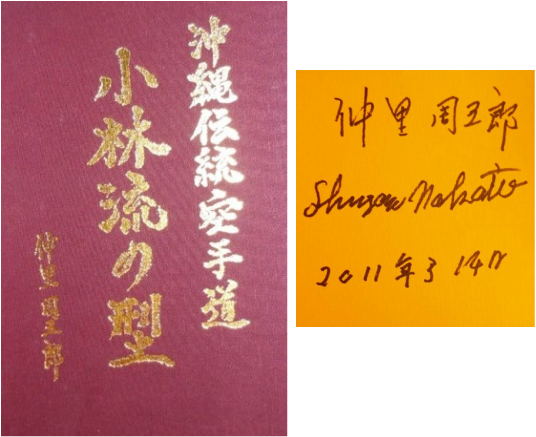
Okinawa Denryu Karate-Do Shorin-Ryu No Kata
by Shugoro Nakazato
March 15, 2005
Japanese language
Signed by Nakazato Sensei (2011)
by Shugoro Nakazato
March 15, 2005
Japanese language
Signed by Nakazato Sensei (2011)
Rare Martial Arts Documents
The following i a handful of rare martial arts-related items in the author's collection.
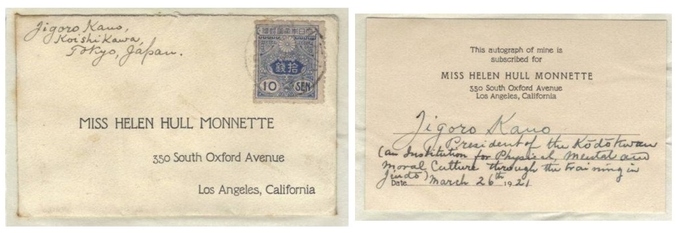
Judo Founder, Jigoro Kano autograph (1921)
Extremely rare autograph card from Judo founder Jigoro Kano dated 1921
Extremely rare autograph card from Judo founder Jigoro Kano dated 1921
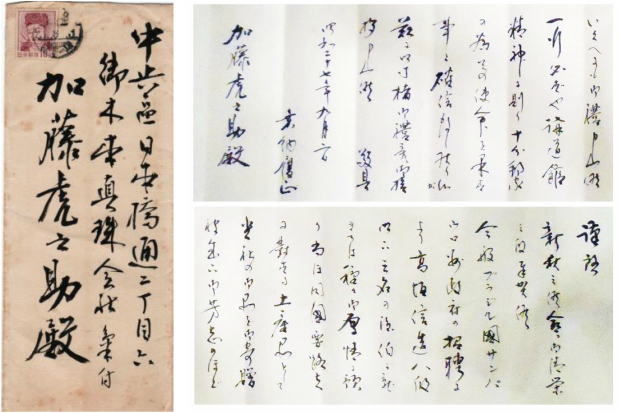
Personal letter from Risei Kano (son of Jigoro Kano) regarding Judo - dated 1952
The Kano letter and Kodokan envelope was personally handwritten by the founder of Judo, Jigoro Kano's son Risei Kano (1900-1986). Risei Kano was the 3rd Kodokan Director, President of the the International Judo Federation and author of several Judo books.
This long letter (measures 37 inches) and is dated September 2, 1952. In the letter he talks about his personal thoughts on Judo. The back of the envelope reads: President of All-Japan Judo Federation, President of Kodokan, Risei Kano
Unfortunately, the details of this letter are very difficulty to accurately translate due to the grass-style cursive (shosho) used by Kano sensei.
The Kano letter and Kodokan envelope was personally handwritten by the founder of Judo, Jigoro Kano's son Risei Kano (1900-1986). Risei Kano was the 3rd Kodokan Director, President of the the International Judo Federation and author of several Judo books.
This long letter (measures 37 inches) and is dated September 2, 1952. In the letter he talks about his personal thoughts on Judo. The back of the envelope reads: President of All-Japan Judo Federation, President of Kodokan, Risei Kano
Unfortunately, the details of this letter are very difficulty to accurately translate due to the grass-style cursive (shosho) used by Kano sensei.
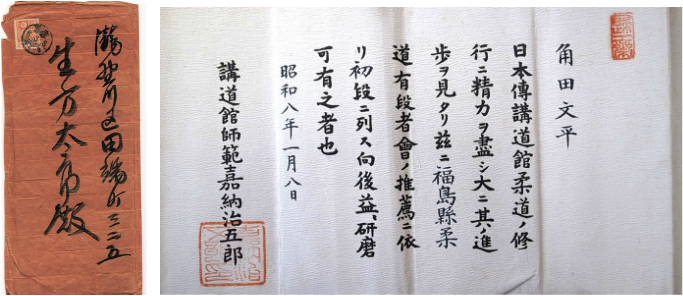
Shodan in Kodokan Judo - signed by Judo founder, Jigoro Kano (dated January 8, 1933)
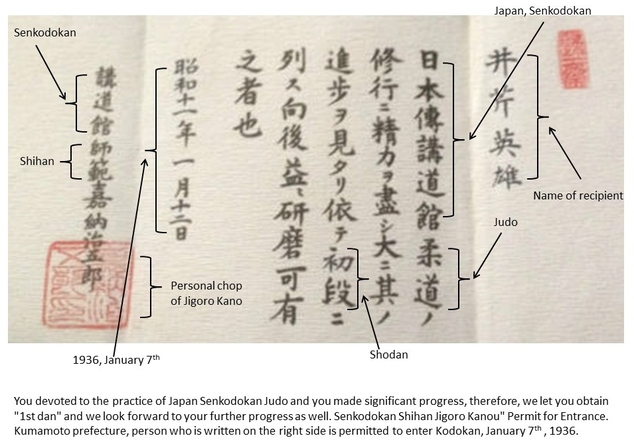
Shodan in Kodokan Judo - signed by Judo founder, Jigoro Kano (dated 1936)

Original photograph of Ryuho Okuyama (1902-1987) the founder of Hakko Ryu Jujutsu (signed and given to one of his students in the 1950's)
Ryuho Okuyama studied Daito Ryu Aikijujutsu (under Hosaku Matsuda and Sokaku Takeda) as well as several other martial arts to include: Seigoryu Jujutsu, Hasegawakoryu Kenjutsu, Nito Ryu Kenjutsu, Sojutsu, Jojutsu, Kyujutsu, and shurikenjutsu. Okuyama was an instructor of Daito Ryu Aikjujtusu until 1939 when he combined his knowledge and experience of martial arts with healing arts and founded Hakko Ryu Ju-jutsu (June 1, 1940). He initially named his organization Dai Nihon Shido-Kai later changing it to Hakko Ryu Kobujuku. Hakko Ryu was so named by Okuyama from the Japanese characters HA which translated means “Eighth” and KO which means “Light”. This comes from the belief that the sun emits eight bands of light (similar to the spectrum of red, orange, yellow, green, blue, indigo and violet).
Ryuho Okuyama studied Daito Ryu Aikijujutsu (under Hosaku Matsuda and Sokaku Takeda) as well as several other martial arts to include: Seigoryu Jujutsu, Hasegawakoryu Kenjutsu, Nito Ryu Kenjutsu, Sojutsu, Jojutsu, Kyujutsu, and shurikenjutsu. Okuyama was an instructor of Daito Ryu Aikjujtusu until 1939 when he combined his knowledge and experience of martial arts with healing arts and founded Hakko Ryu Ju-jutsu (June 1, 1940). He initially named his organization Dai Nihon Shido-Kai later changing it to Hakko Ryu Kobujuku. Hakko Ryu was so named by Okuyama from the Japanese characters HA which translated means “Eighth” and KO which means “Light”. This comes from the belief that the sun emits eight bands of light (similar to the spectrum of red, orange, yellow, green, blue, indigo and violet).

Tatsuo Shimabuku signed Rank certificate
3rd Kyu (Brown Belt) rank promotion certificate in Isshin Ryu Karate - signed by founder Tatsuo Shimabuku (dated 1970)
